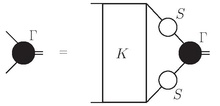Bethe-Salpeter equation
The Bethe-Salpeter equation (after Hans Bethe and Edwin Salpeter 1951) describes bonding states of a quantum field theoretical two-body system.
Since the Bethe-Salpeter equation is used in many areas of theoretical physics, there are also different spellings. A shape that is often used in particle physics is
where Γ represents the solution of the Bethe-Salpeter equation, the Bethe-Salpeter amplitude, K the interaction nucleus and S the propagators of the particles that form the bond state (hereinafter referred to as constituents).
In a quantum theory, bond states are stable, that is, they exist infinitely long and so their constituents can interact with each other infinitely often. The Bethe-Salpeter equation describes these states by iterating infinitely many times every possible interaction that can happen between the two constituents. Their solution, the Bethe-Salpeter-Amplitude describes the binding state, e.g. B. in place or in momentum space.
Possible applications of the Bethe-Salpeter equation are the hydrogen atom , positronium , excitons and mesons .
Derivation
A derivation of the Bethe-Salpeter equation is based on the fact that bond states are poles in Green's functions of theory.
To do this, start with the Dyson equation for the 4-point functions
where the 4-point Green function , are the propagators and the interaction kernel, which contains all two-particle irreducible interactions.
With the help of the so-called Bethe-Saltpeter wave functions , which can be viewed as the transition amplitude of the two constituents in the bond state, one can apply Green's function as
- .
where represents the total momentum of the system and the mass of the bound state. For this approach has a pole which corresponds exactly to the mass shell condition for relativistic momentum.
If you go into the Dyson equation above with this approach, you get
where, one sets , both sides are dominated by their residuals and one obtains
- .
This is already a form of the Bethe-Salpeter equation. Often the Bethe-Saltpeter amplitudes Oft are introduced as
which gives the above form of the Bethe-Salpeter equation:
- .
Approximations
Since the Bethe-Salpeter equation contains all possible interactions between the two constituents, a complete solution is seldom (if at all) possible and approximations are necessary in practical calculations.
- One possibility is to assume one of the particles is much heavier than the other and then solve the Dirac equation of a (the light) particle in a potential.
- If you really want to solve the Bethe-Salpeter equation, in contrast to above, you have to model the interaction kernel. In quantum field theories, interactions through particle exchange are described. The simplest assumption about the interaction nucleus is that it consists exactly of the exchange of one of these force particles (e.g. photons in quantum electrodynamics , gluons in quantum chromodynamics ) between the two constituents, which is then repeated infinitely often. Since the corresponding Feynman diagram is similar to a ladder, this approximation is called the ladder approximation (or rainbow ladder approximation) of the Bethe-Salpeter equation.
See also
Web links
The Bethe-Salpeter Equation (English)
Individual evidence
- ^ H. Bethe, E. Salpeter: A Relativistic Equation for Bound-State Problems . In: Physical Review . tape 82 , no. 2 , April 15, 1951, p. 309-310 , doi : 10.1103 / PhysRev.82.291 (part of the Proceedings of the American Physical Society. New York, February 1-3, 1951).
- ^ EE Salpeter, HA Bethe: A Relativistic Equation for Bound-State Problems . In: Physical Review . tape 84 , no. 6 , December 15, 1951, p. 1232 , doi : 10.1103 / PhysRev.84.1232 .
- ^ WA Newcomb, EE Salpeter: Mass Corrections to the Hyperfine Structure in Hydrogen . In: Physical Review . tape 97 , no. 4 , February 15, 1955, p. 1146–1158 , doi : 10.1103 / PhysRev.97.1146 .
- ^ Mildred S. Dresselhaus, Gene Dresselhaus, Riichiro Saito, Ado Jorio: Exciton Photophysics of Carbon Nanotubes . In: Annual Review of Physical Chemistry . tape 58 , no. 1 , May 2007, p. 719-747 , doi : 10.1146 / annurev.physchem.58.032806.104628 .
- ^ DB Leinweber, L. von Smekal, AG Williams, P. Maris, PC Tandy: Proceedings of the Cairns Topical Workshop on Light-Cone QCD and Nonperturbative Hadron PhysicsQCD modeling of hadron physics . In: Nuclear Physics B . tape 161 , November 2006, p. 136–152 , here p. 136. , doi : 10.1016 / j.nuclphysbps.2006.08.012 .
















